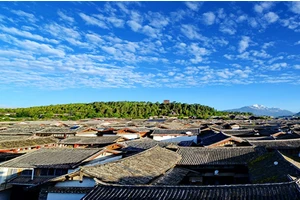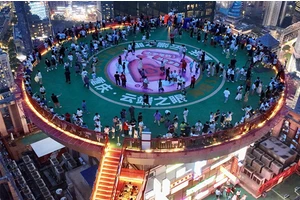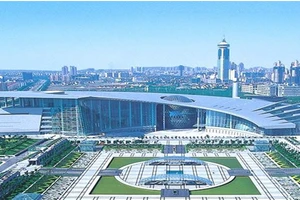Gurao travel
Gurao Town is located in the northwest of Chaoyang District, Shantou City, Guangdong Province, at the southern foot of Xiaobei Mountain, at the junction of Chaoyang, Puning and Jieyang. The provincial highway Red River runs through the whole territory. The town covers an area of 71.8 square kilometers, including 24,000 mu of cultivated land and 4.6 mu of mountainous area. It has jurisdiction over 5 residents' committees and 21 villagers' committees with a total population of 132,000. It is one of the key hometown of overseas Chinese in Chaoyang District. Rao's township enterprises are very developed, and the knitting underwear industry is even more famous. Since the reform and opening up, the Gurao Town Committee and the town government have implemented the development strategy of "stabilizing the town through agriculture and forestry, enriching the town through industry, invigorating the town through commerce and science and education" around the goal of building a modern industrial town, leading the masses to strive to build their own beautiful homes and achieving fruitful results. [Edit this paragraph] Economic situation The industrial economy has recovered. First, implement the measures to help workers, support the development of enterprises, and make the whole town form a big industrial boom; The second is to introduce high-tech projects, with an annual investment of 80 million yuan, and launch six production projects, including Mo Lifeng computer embroidery and Xinxing Ya weaving. More than 140 sets of advanced equipment such as large-scale computerized embroidery machine and warp knitting machine were introduced, with an annual added output value of 150 million yuan; Third, the brand strategy was implemented, and 30 new trademarks were added throughout the year, totaling 370, of which "Yachao", "Guanghua", "New Step" and "Ousland" were the key protected trademarks in Shantou; Fourth, broaden trade channels, and organize enterprises such as Xiadaifang Underwear Co., Ltd., Shi Jia Industrial Co., Ltd. and Raomei Industrial Co., Ltd. to participate in the 2001 Chaoshan Famous and Special Products (Beijing) Exhibition and Shantou Commodity Fair in Chongqing, so as to improve the visibility of Gurao enterprises. Agricultural production has developed steadily.The annual grain planting area was 44,900 mu, and the total grain output was 18,971 tons. Invest 3 million yuan to build farmland water conservancy facilities and improve agricultural production conditions. Breakthroughs have been made in urban infrastructure construction. About 16 million yuan was invested to build the renovation project (cement pavement, 4.13 kilometers long and 24 meters wide) of the Gulao section of the Red River Line. One 35 kV transformer, 20 dedicated power supply stations, 2,500 pairs of telecom backbones and 22,500 telephone users were added. Carry out a series of activities to create spiritual civilization, build educational office buildings, speed up the construction process of Shangbao Middle School, and improve the school environment [1]. [Edit this paragraph] Historical evolution Gurao Township was once called Gurao, which was built in 1391 AD in the twenty-fourth year of Ming Hongwu. Qing Ji's original idea in Red Liao wrote: "Xiabao Huali was renamed Xiajia, and now it is called Huaguang". During the Chongzhen period of Ming Dynasty and Yongzheng period of Qing Dynasty, Zhang Chuangda's fifth grandson moved from Chiliao to Shangjia in the 8th century. Prior to this, Zhang Yujiang, the second first grandson, settled in Wumenlou and Fannie and Freddie Port. After the development and reproduction of the Zhang family, Shangbao Maoguang West Wei is emerging and gradually called Chiliao Township. In the 16th year of the Republic of China, "1927 AD" was renamed as Gurao Township, which meant a bumper harvest. Xingren Township in Song and Yuan Dynasties, Guishan Capital from Ming and Qing Dynasties to the early Republic of China, and the sixth district of Chaoyang County from the tenth year of the Republic of China (1921). Gurao Township in 1956, Hongfeng People's Commune in 1958, Gurao People's Commune in 1959, Gurao District in 1983 and Gurao Town in 1986.[Edit this paragraph] Geographical location: Gurao Town is located at the southern foot of Xiaobei Mountain, with 116 24 _ east longitude and 23 21 _ north latitude. It is adjacent to Xilu Town in the east, Tongyu Town in the south, Guiyu Town in the west, Jinyu Town and Zaopu Town in the north, 26 kilometers away from Chaoyang City and 4 kilometers away from Lingshan Temple, a provincial key cultural relics protection unit. [Edit this paragraph] The natural environment gradually inclines from northwest to southeast, belonging to the semi-hilly plain area. The winding water originates from the southern foot of Qingpai Mountain in Xiaobeishan Jujube Shop, from Heyuan to the west side of Xidongzai in Tongyu Town, and reaches the middle reaches of Lianjiang River, with a total length of 24.1 kilometers. It has a subtropical monsoon climate, with an average annual temperature of 21.4℃ and an average annual precipitation of 1820mm. [Edit this paragraph] The population of Gurao Town is 132,000, with the Han nationality accounting for 99.88% and the Zhuang, Li and Miao ethnic minorities accounting for 0.12%. There are more than 100,000 overseas Chinese, overseas Chinese and compatriots from Hong Kong, Macao and Taiwan. It is one of the key hometown of overseas Chinese in Chaoyang District. Administrative structure: Gurao Town has five neighborhood committees: Shangbao, Guang Mao, Huaguang, Xinpo and Xinxing, as well as Dakeng, Messi, Xincuo, Toupu, Dongming, Dongxing, Hengshan, Gounan, Hougou, Wujiao, Guantian, Li Antang, Jingjiao, Tunnei, Xiandi, yang shen, Gan 'an and Xinxian. [Edit this paragraph] Cultural activities The mass cultural activities in Gurao Town are active and large in scale. Especially on holidays, organize various cultural and sports activities to enliven the entertainment life of the masses. There is an amateur literary and artistic creation team in the town, which is active in literature and painting. It's called Little Red Flower at the foot of Xiaobei Mountain. They sometimes hold large-scale literary evenings with relevant units.Sometimes, the neighborhood committees host exhibitions of calligraphy and painting collections. During the Spring Festival in 1995, an exhibition of paintings and calligraphy by Zhang Yongli, Zhang Xiaobin and Zhang Yingping was held. It includes the works of famous painters and painters in Ming and Qing dynasties and contemporary times. In May, 1997, an exhibition of calligraphy and painting was held to commemorate the May 4th Movement and welcome the return of Hong Kong. There were 68 old, middle-aged and young writers and 135 works. During the Spring Festival in 2004, an exhibition of photographs by Chen, He and Zhang Haipeng was held. In order to promote the development of cultural undertakings, the town contacted Chaoyang Propaganda and Culture Department, organized some writers to interview relevant enterprises in the town, made in-depth reports on the development of township enterprises, and made special reports in newspapers and magazines to reflect the development of large and medium-sized enterprises since the reform and opening up. In terms of literary creation, the essays and novels of amateur writers Lin Xiangxiong and Zhang Yiying have made their mark in Beijing, Guangzhou and Hong Kong, and they are quite famous in Chaoyang literary world in eastern Guangdong. Lin Xiangxiong has published "Soul of the Ancient City" and "Walking in the Clouds and Water". Zhang Yiying's creation is in the ascendant. In recent years, she has published collections of essays such as Not Only Remembering, The Fork of Life and Yesterday's Story. Among them, the prose "Father and Book" won the first prize in Literary and Art Newspaper and People's Daily, and was awarded the first prize of amateur creation by the Literary and Art Federation of Chaoyang Cultural Bureau for many years. Rao Town's cultural activities can be actively carried out because it has a mass creative team. In the amateur calligraphy and painting exhibition, Zhang Yingping, Zhang Baosheng and Zhang Chuping from Shangbao, Huang Jianzhou, Zhang and Luo, and Zhang Yingshun and Zhang from Huaguang are all pioneers of Gu Rao's cultural work. Gu Rao's folk cultural activities will continue to develop with the passage of time.Several villages (residences) in the township hold sacrificial activities every ten years. By commemorating the anti-Yuan activities of Wen Tianxiang and other subordinates in the Southern Song Dynasty, we encourage the masses to carry forward national integrity, create two civilizations, and mobilize overseas Chinese at home and abroad to join in the construction of their hometown, singing and dancing. In April and December, 1998, a total of 12 units in 5 villages in the township held cultural performances, 13 male and female English singing teams, 15 Chaozhou flute and gongs and drums teams and 20 dance teams performed in the streets. At the same time, cultural groups from Shaanxi, Liaoning, Guangxi, Fujian and other places participated in tourism performances, which were very popular. There are many cultural activities in Rao town, such as library, cable TV station and cultural activity center for respecting the elderly. Cultural rooms are generally built in villages (residences), and mass cultural activities are very active. There are 20 teams in the hometown of song and dance, among which the performance of Dongming Ying Ge team at' 97 Chaoyang Song and Dance Festival was well received; The Youth English Singing Team of Shangbao Second Village participated in the '99 Chaoyang Spring Festival Parade; Youth teams and gongs and drums teams participated in Shantou 99 Spring Festival cultural parade; Xianbo Junior Flute Orchestra Music Team won the second place in the first Flute Orchestra Music Competition in Chaoyang; In 2003, organize teachers and students of the education system to participate in the National Day cultural performance in the whole region; In 2003-2004, China Chess Competition was held. [Edit this paragraph] Folklore According to the introduction of the elderly villagers in Gurao Town, the "2008 Folk Culture Festival" in Gurao Town evolved from the development of Gu Rao's sacrificial society. Sacrificial society has a history of more than 600 years since the Ming Dynasty. It was originally to commemorate Wen Tianxiang and the soldiers who died in the Southern Song Dynasty. There are many legends about Wen Tianxiang circulating around Gurao Town, Chaoyang District.Legend has it that at the end of the Southern Song Dynasty, Yuan soldiers invaded. Wen Tianxiang, the right prime minister, attempted to restore the country in Chaoyang, and was captured in Haifeng County during the campaign. Commander-in-Chief Chen Yi colluded with rebel Zhang Hongfan and fought bloody battles with Song Jun at the foot of Xiaobei Mountain. Because of the disparity in strength between the two sides, most people in Song Jun died here. Ming Taizu named the soldiers who died in the Anti-Yuan War at the end of the Song Dynasty as "marshals", and appointed villages adjacent to the Anti-Yuan War, such as Kameyama Chiliao (formerly known as Gu Rao), to regularly offer sacrifices to the soldiers who died that year. Gu Rao and other places began to sacrifice to the society. Folk repair of the solitary burial of soldiers killed in the late Song Dynasty is called "Marshal Song's Tomb", and all ethnic groups in each township pay homage in time by stages. According to the investigation, there are 9 tombs of Song Dynasty in Gurao and surrounding villages. [2][ Edit this paragraph] Gu Rao, a tourist resource, is located at the southwest foot of Chaoyang Shanxi. During the Kangxi period of the Qing Dynasty, it was under the jurisdiction of Guishan Capital, with vast territory and abundant resources and rich cultural heritage. Zhang Xun (1686-1760) in Chiliao Township, Liu (1894-1975) in Xianpo Township and Chen Meisheng (1894-1975) in Shenyang Township, Wen Tianxiang, the national hero of the Southern Song Dynasty who fought bloody battles at the foot of Xiaobeishan, the capital of Guishan Mountain, left many touching legends and historical sites for people to mourn. Moreover, the cultural relics of Confucianism, Buddhism and Taoism are scattered all over the world. Among them, Guishan Academy founded by Zhang Xun (Zizhen), Marshal Song Cemetery to commemorate the national heroes who fought against Yuan Dynasty at the end of Song Dynasty, Chiduling (Dry Emperor Temple), the former site of the Red Army Revolution led by He Long and Ye Ting in 1927, and Xiaoke Building founded by the father of patriotic overseas Chinese leaders in Wuchang in 1937, etc., all received higher education. Besides,There are also Wu Meng, a medicine fairy in Jin Dynasty, Wuwenzhen Monastery in Xu Xun, Guandi Temple in Huaguang Township, Rao Qing 'an, Puji 'an in Xinliao and Kannonji in Guang Mao. , are historical sites of Buddhism and Taoism. What is even more impressive is that on the first day of this year's Spring Festival, China Central Television (CCTV) launched the "Mazu family ancestral temple" in Shenyang Township, Gurao Town with the theme of "Hall of Folk Art", a private ancestral hall covering an area of 1,500 square meters and integrating traditional folk crafts such as stone carving, wood carving and porcelain inlay. It was built in 1921 by Mr. Chen Meisheng, a famous sage in his hometown during the Republic of China. When Mei Sheng died in 1929, the project was still unfinished. It was built by Chen Zuwu (then the county magistrate of Puning County) and lasted for nearly ten years. Hire all kinds of artists with unique skills in Chaoshan to create them carefully. More than 300 pieces of wood carvings and more than 200 pieces of stone carvings and decorative works have been preserved, which have condensed the hard work of folk artists and left very precious artistic materials for future generations.
Gu Rao, located at the southern foot of Xiaobei Mountain in Chaoyang, was under the jurisdiction of Guishan Capital during the reign of Emperor Kangxi of Qing Dynasty, with a vast territory, abundant resources and rich cultural accumulation. He was Zhang Xun in Chiliao Township (1686-1760), Liu Houwu in Xianpo Township (1894-1975) and Chen Meisheng in Shenyang Township (1875-1929). Wen Tianxiang, an anti-Yuan national hero in the Southern Song Dynasty, entered the tide and fought bloody battles at the foot of Xiaobei Mountain, the capital of Gugui Mountain, leaving many touching legends and historical relics for people to mourn, and the cultural relics of Confucianism, Buddhism and Taoism in the past dynasties were scattered all over the place. Among them, Guishan Academy, which was founded by Zhang Xun (Zizhen), Marshal Song's Cemetery, which commemorates the national heroes who fought against Yuan Dynasty at the end of Song Dynasty, Chiduling, the former site of Red Army Revolution, which was run by He Long and Ye Ting in 1927, and Xiaokelou, the father of patriotic overseas Chinese leader Zhang Xiaolu, which was founded in 1937, have all been established by the cultural and cultural departments at higher levels. In addition, Wu Meng, a medicine fairy in the Jin Dynasty, the "Wenwu Zhenjun Temple" in Xu Xun, the "Guandi Temple" in Huaguang Township, Raoqing 'an, Puji Temple in Xinliao, and Kannonji in Maoguang, etc., are all historical Buddhist and Taoist wonders. What's even more amazing is that on the first day of the Spring Festival, CCTV grandly promoted the "Mei Zujia Temple" in Shenyang Township, Gurao Town with the theme of "Folk Art Palace"-a private ancestral temple covering an area of 1,500 square meters and integrating traditional folk crafts of stone carving, wood carving and porcelain inlay. It was founded in 1921 by Mr. Chen Meisheng, a famous rural sage of the Republic of China.Until the death of Mei Sheng in 1929, the project was still unfinished. It was continued by the eldest son Chen Zuwu (then the county magistrate of Puning County), and lasted for nearly ten years. It was carefully constructed by all kinds of artists who had unique skills in Chaoshan that year. More than 300 pieces of wood carvings and more than 200 pieces of stone carvings have been preserved, which condensed the painstaking efforts of folk artists and left a very precious artistic material for future generations.






